Easy Jet Plc Finance: Ratio Analysis, Budget Preparation & Investment
VerifiedAdded on 2023/06/11
|17
|3940
|92
Report
AI Summary
This report provides a comprehensive financial analysis of Easy Jet Plc, a British multinational low-cost airline group. It evaluates the company's financial performance using ratio analysis, including profitability, liquidity, efficiency, and financial gearing ratios, while also discussing the limitations of these ratios. The report further explores budget preparation, highlighting the benefits and limitations of budgeting and comparing incremental and zero-based budgeting approaches. It critically assesses the role of performance management in decision-making, particularly during challenging times like the Covid-19 pandemic. Finally, the report examines investment appraisal techniques such as Net Present Value (NPV) and Internal Rate of Return (IRR), considering the risks and uncertainties involved and suggesting appropriate financing methods. The document concludes with a summary of the key findings and recommendations. Desklib provides access to this and other solved assignments to support student learning.

ELEMENT
INDIVIDUAL
ASSIGNMENT
INDIVIDUAL
ASSIGNMENT
Paraphrase This Document
Need a fresh take? Get an instant paraphrase of this document with our AI Paraphraser

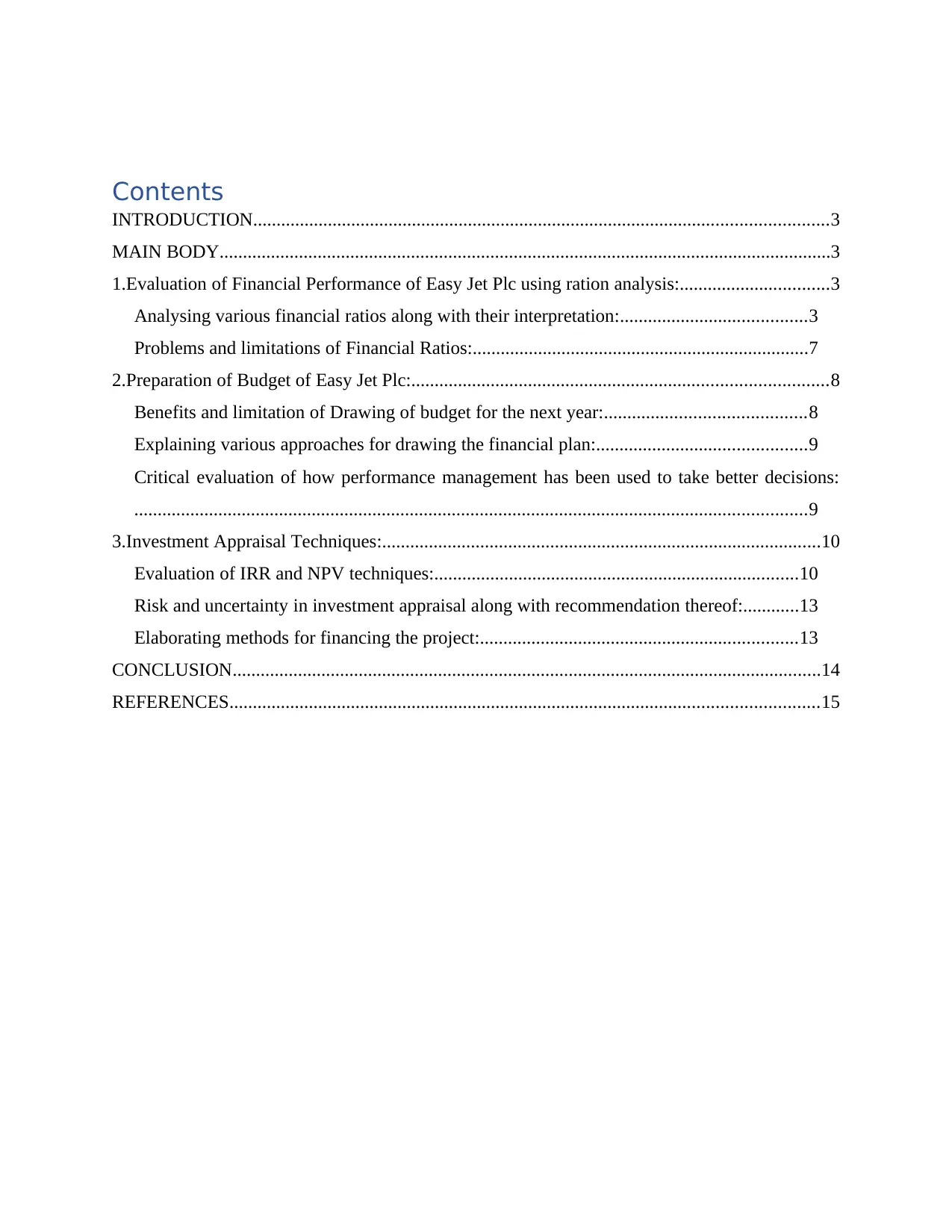
Contents
INTRODUCTION...........................................................................................................................3
MAIN BODY...................................................................................................................................3
1.Evaluation of Financial Performance of Easy Jet Plc using ration analysis:................................3
Analysing various financial ratios along with their interpretation:........................................3
Problems and limitations of Financial Ratios:........................................................................7
2.Preparation of Budget of Easy Jet Plc:.........................................................................................8
Benefits and limitation of Drawing of budget for the next year:...........................................8
Explaining various approaches for drawing the financial plan:.............................................9
Critical evaluation of how performance management has been used to take better decisions:
................................................................................................................................................9
3.Investment Appraisal Techniques:..............................................................................................10
Evaluation of IRR and NPV techniques:..............................................................................10
Risk and uncertainty in investment appraisal along with recommendation thereof:............13
Elaborating methods for financing the project:....................................................................13
CONCLUSION..............................................................................................................................14
REFERENCES..............................................................................................................................15
INTRODUCTION...........................................................................................................................3
MAIN BODY...................................................................................................................................3
1.Evaluation of Financial Performance of Easy Jet Plc using ration analysis:................................3
Analysing various financial ratios along with their interpretation:........................................3
Problems and limitations of Financial Ratios:........................................................................7
2.Preparation of Budget of Easy Jet Plc:.........................................................................................8
Benefits and limitation of Drawing of budget for the next year:...........................................8
Explaining various approaches for drawing the financial plan:.............................................9
Critical evaluation of how performance management has been used to take better decisions:
................................................................................................................................................9
3.Investment Appraisal Techniques:..............................................................................................10
Evaluation of IRR and NPV techniques:..............................................................................10
Risk and uncertainty in investment appraisal along with recommendation thereof:............13
Elaborating methods for financing the project:....................................................................13
CONCLUSION..............................................................................................................................14
REFERENCES..............................................................................................................................15
⊘ This is a preview!⊘
Do you want full access?
Subscribe today to unlock all pages.

Trusted by 1+ million students worldwide
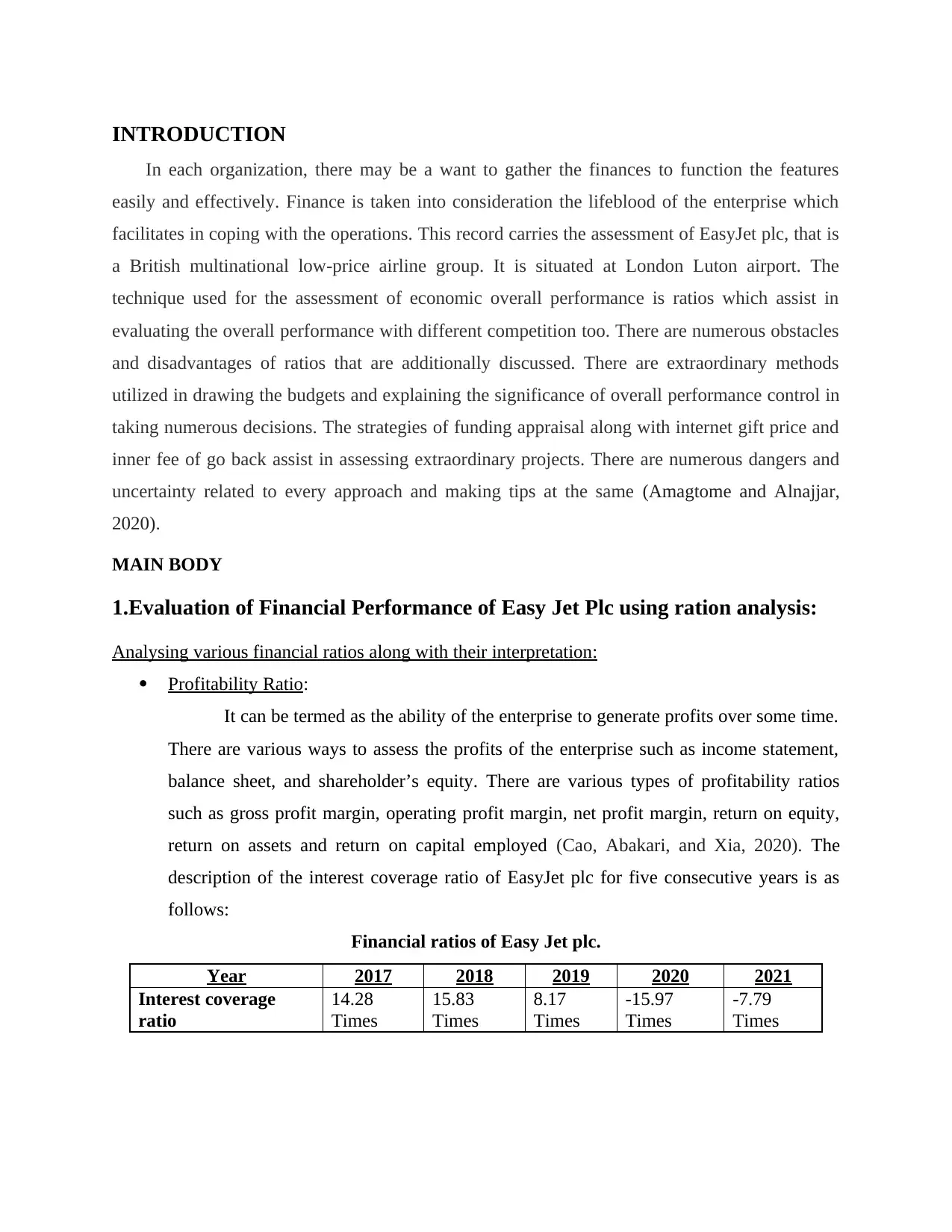
INTRODUCTION
In each organization, there may be a want to gather the finances to function the features
easily and effectively. Finance is taken into consideration the lifeblood of the enterprise which
facilitates in coping with the operations. This record carries the assessment of EasyJet plc, that is
a British multinational low-price airline group. It is situated at London Luton airport. The
technique used for the assessment of economic overall performance is ratios which assist in
evaluating the overall performance with different competition too. There are numerous obstacles
and disadvantages of ratios that are additionally discussed. There are extraordinary methods
utilized in drawing the budgets and explaining the significance of overall performance control in
taking numerous decisions. The strategies of funding appraisal along with internet gift price and
inner fee of go back assist in assessing extraordinary projects. There are numerous dangers and
uncertainty related to every approach and making tips at the same (Amagtome and Alnajjar,
2020).
MAIN BODY
1.Evaluation of Financial Performance of Easy Jet Plc using ration analysis:
Analysing various financial ratios along with their interpretation:
Profitability Ratio:
It can be termed as the ability of the enterprise to generate profits over some time.
There are various ways to assess the profits of the enterprise such as income statement,
balance sheet, and shareholder’s equity. There are various types of profitability ratios
such as gross profit margin, operating profit margin, net profit margin, return on equity,
return on assets and return on capital employed (Cao, Abakari, and Xia, 2020). The
description of the interest coverage ratio of EasyJet plc for five consecutive years is as
follows:
Financial ratios of Easy Jet plc.
Year 2017 2018 2019 2020 2021
Interest coverage
ratio
14.28
Times
15.83
Times
8.17
Times
-15.97
Times
-7.79
Times
In each organization, there may be a want to gather the finances to function the features
easily and effectively. Finance is taken into consideration the lifeblood of the enterprise which
facilitates in coping with the operations. This record carries the assessment of EasyJet plc, that is
a British multinational low-price airline group. It is situated at London Luton airport. The
technique used for the assessment of economic overall performance is ratios which assist in
evaluating the overall performance with different competition too. There are numerous obstacles
and disadvantages of ratios that are additionally discussed. There are extraordinary methods
utilized in drawing the budgets and explaining the significance of overall performance control in
taking numerous decisions. The strategies of funding appraisal along with internet gift price and
inner fee of go back assist in assessing extraordinary projects. There are numerous dangers and
uncertainty related to every approach and making tips at the same (Amagtome and Alnajjar,
2020).
MAIN BODY
1.Evaluation of Financial Performance of Easy Jet Plc using ration analysis:
Analysing various financial ratios along with their interpretation:
Profitability Ratio:
It can be termed as the ability of the enterprise to generate profits over some time.
There are various ways to assess the profits of the enterprise such as income statement,
balance sheet, and shareholder’s equity. There are various types of profitability ratios
such as gross profit margin, operating profit margin, net profit margin, return on equity,
return on assets and return on capital employed (Cao, Abakari, and Xia, 2020). The
description of the interest coverage ratio of EasyJet plc for five consecutive years is as
follows:
Financial ratios of Easy Jet plc.
Year 2017 2018 2019 2020 2021
Interest coverage
ratio
14.28
Times
15.83
Times
8.17
Times
-15.97
Times
-7.79
Times
Paraphrase This Document
Need a fresh take? Get an instant paraphrase of this document with our AI Paraphraser
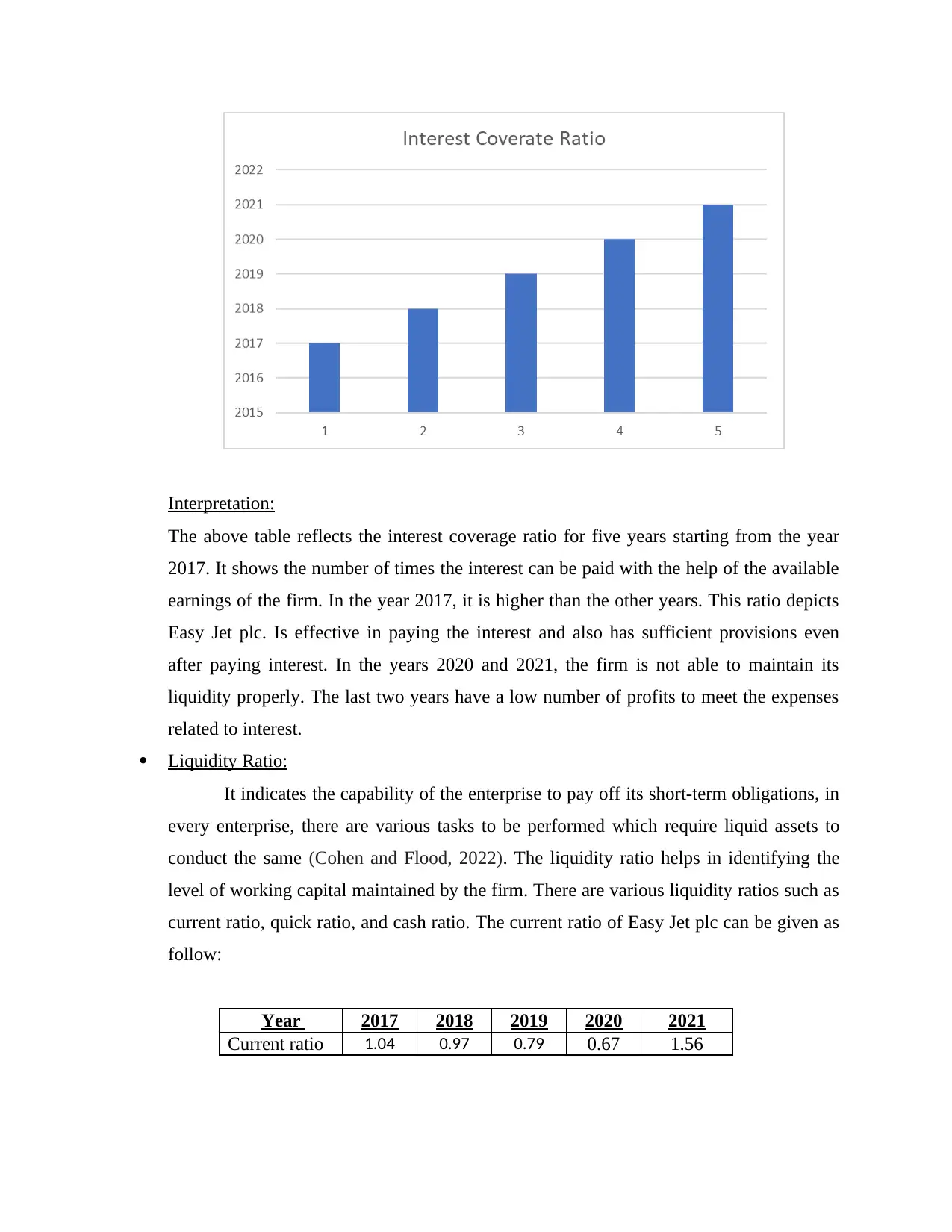
Interpretation:
The above table reflects the interest coverage ratio for five years starting from the year
2017. It shows the number of times the interest can be paid with the help of the available
earnings of the firm. In the year 2017, it is higher than the other years. This ratio depicts
Easy Jet plc. Is effective in paying the interest and also has sufficient provisions even
after paying interest. In the years 2020 and 2021, the firm is not able to maintain its
liquidity properly. The last two years have a low number of profits to meet the expenses
related to interest.
Liquidity Ratio:
It indicates the capability of the enterprise to pay off its short-term obligations, in
every enterprise, there are various tasks to be performed which require liquid assets to
conduct the same (Cohen and Flood, 2022). The liquidity ratio helps in identifying the
level of working capital maintained by the firm. There are various liquidity ratios such as
current ratio, quick ratio, and cash ratio. The current ratio of Easy Jet plc can be given as
follow:
Year 2017 2018 2019 2020 2021
Current ratio 1.04 0.97 0.79 0.67 1.56
The above table reflects the interest coverage ratio for five years starting from the year
2017. It shows the number of times the interest can be paid with the help of the available
earnings of the firm. In the year 2017, it is higher than the other years. This ratio depicts
Easy Jet plc. Is effective in paying the interest and also has sufficient provisions even
after paying interest. In the years 2020 and 2021, the firm is not able to maintain its
liquidity properly. The last two years have a low number of profits to meet the expenses
related to interest.
Liquidity Ratio:
It indicates the capability of the enterprise to pay off its short-term obligations, in
every enterprise, there are various tasks to be performed which require liquid assets to
conduct the same (Cohen and Flood, 2022). The liquidity ratio helps in identifying the
level of working capital maintained by the firm. There are various liquidity ratios such as
current ratio, quick ratio, and cash ratio. The current ratio of Easy Jet plc can be given as
follow:
Year 2017 2018 2019 2020 2021
Current ratio 1.04 0.97 0.79 0.67 1.56
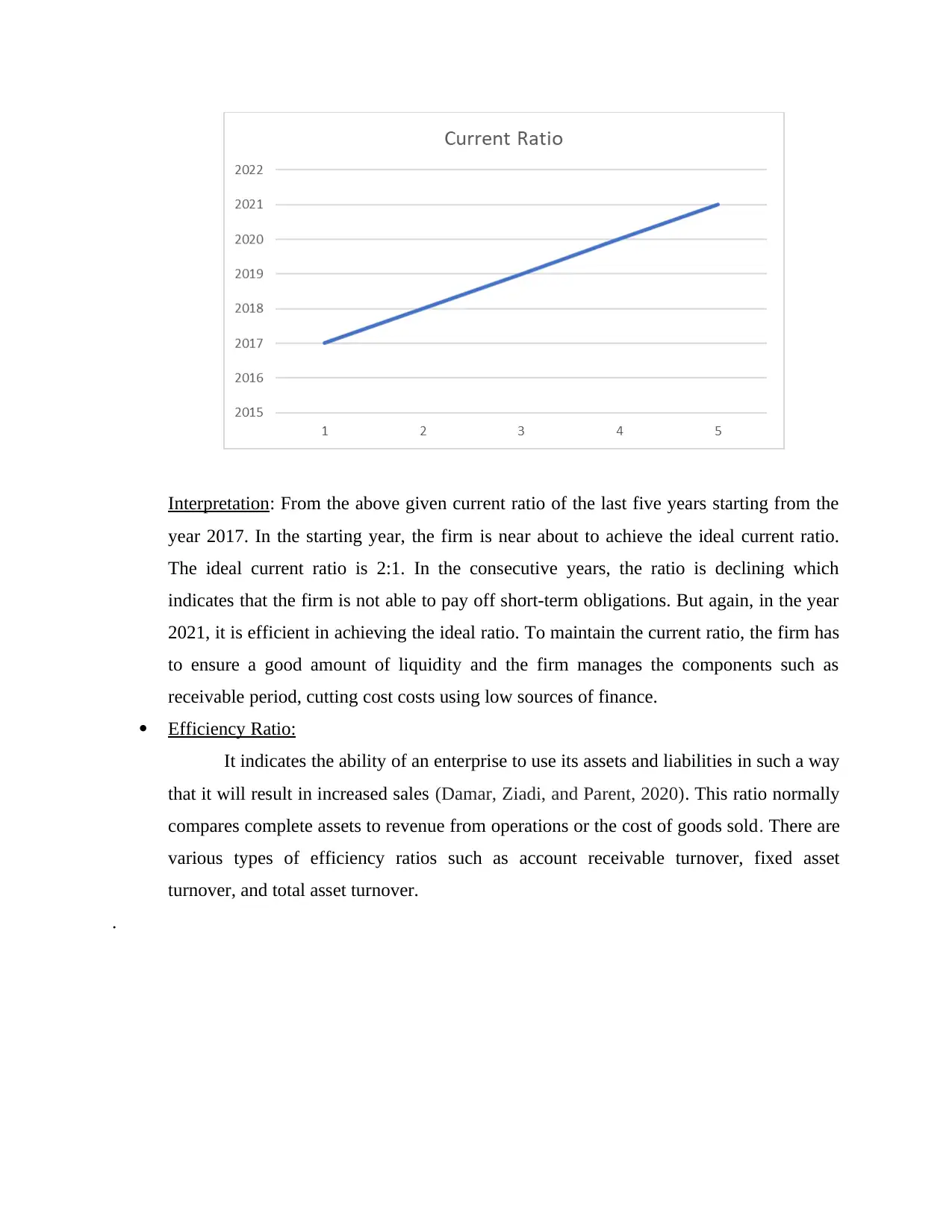
Interpretation: From the above given current ratio of the last five years starting from the
year 2017. In the starting year, the firm is near about to achieve the ideal current ratio.
The ideal current ratio is 2:1. In the consecutive years, the ratio is declining which
indicates that the firm is not able to pay off short-term obligations. But again, in the year
2021, it is efficient in achieving the ideal ratio. To maintain the current ratio, the firm has
to ensure a good amount of liquidity and the firm manages the components such as
receivable period, cutting cost costs using low sources of finance.
Efficiency Ratio:
It indicates the ability of an enterprise to use its assets and liabilities in such a way
that it will result in increased sales (Damar, Ziadi, and Parent, 2020). This ratio normally
compares complete assets to revenue from operations or the cost of goods sold. There are
various types of efficiency ratios such as account receivable turnover, fixed asset
turnover, and total asset turnover.
.
year 2017. In the starting year, the firm is near about to achieve the ideal current ratio.
The ideal current ratio is 2:1. In the consecutive years, the ratio is declining which
indicates that the firm is not able to pay off short-term obligations. But again, in the year
2021, it is efficient in achieving the ideal ratio. To maintain the current ratio, the firm has
to ensure a good amount of liquidity and the firm manages the components such as
receivable period, cutting cost costs using low sources of finance.
Efficiency Ratio:
It indicates the ability of an enterprise to use its assets and liabilities in such a way
that it will result in increased sales (Damar, Ziadi, and Parent, 2020). This ratio normally
compares complete assets to revenue from operations or the cost of goods sold. There are
various types of efficiency ratios such as account receivable turnover, fixed asset
turnover, and total asset turnover.
.
⊘ This is a preview!⊘
Do you want full access?
Subscribe today to unlock all pages.

Trusted by 1+ million students worldwide
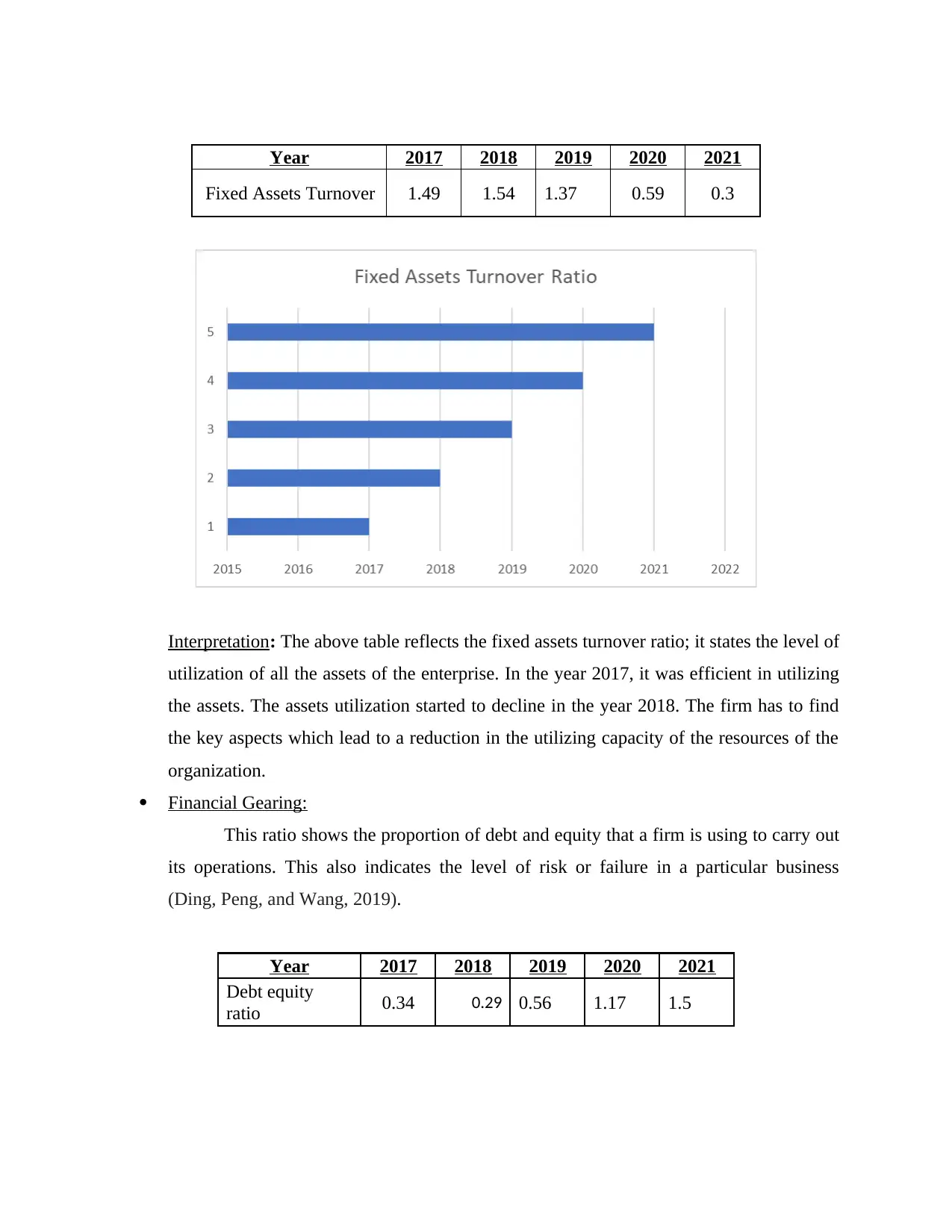
Year 2017 2018 2019 2020 2021
Fixed Assets Turnover 1.49 1.54 1.37 0.59 0.3
Interpretation: The above table reflects the fixed assets turnover ratio; it states the level of
utilization of all the assets of the enterprise. In the year 2017, it was efficient in utilizing
the assets. The assets utilization started to decline in the year 2018. The firm has to find
the key aspects which lead to a reduction in the utilizing capacity of the resources of the
organization.
Financial Gearing:
This ratio shows the proportion of debt and equity that a firm is using to carry out
its operations. This also indicates the level of risk or failure in a particular business
(Ding, Peng, and Wang, 2019).
Year 2017 2018 2019 2020 2021
Debt equity
ratio 0.34 0.29 0.56 1.17 1.5
Fixed Assets Turnover 1.49 1.54 1.37 0.59 0.3
Interpretation: The above table reflects the fixed assets turnover ratio; it states the level of
utilization of all the assets of the enterprise. In the year 2017, it was efficient in utilizing
the assets. The assets utilization started to decline in the year 2018. The firm has to find
the key aspects which lead to a reduction in the utilizing capacity of the resources of the
organization.
Financial Gearing:
This ratio shows the proportion of debt and equity that a firm is using to carry out
its operations. This also indicates the level of risk or failure in a particular business
(Ding, Peng, and Wang, 2019).
Year 2017 2018 2019 2020 2021
Debt equity
ratio 0.34 0.29 0.56 1.17 1.5
Paraphrase This Document
Need a fresh take? Get an instant paraphrase of this document with our AI Paraphraser
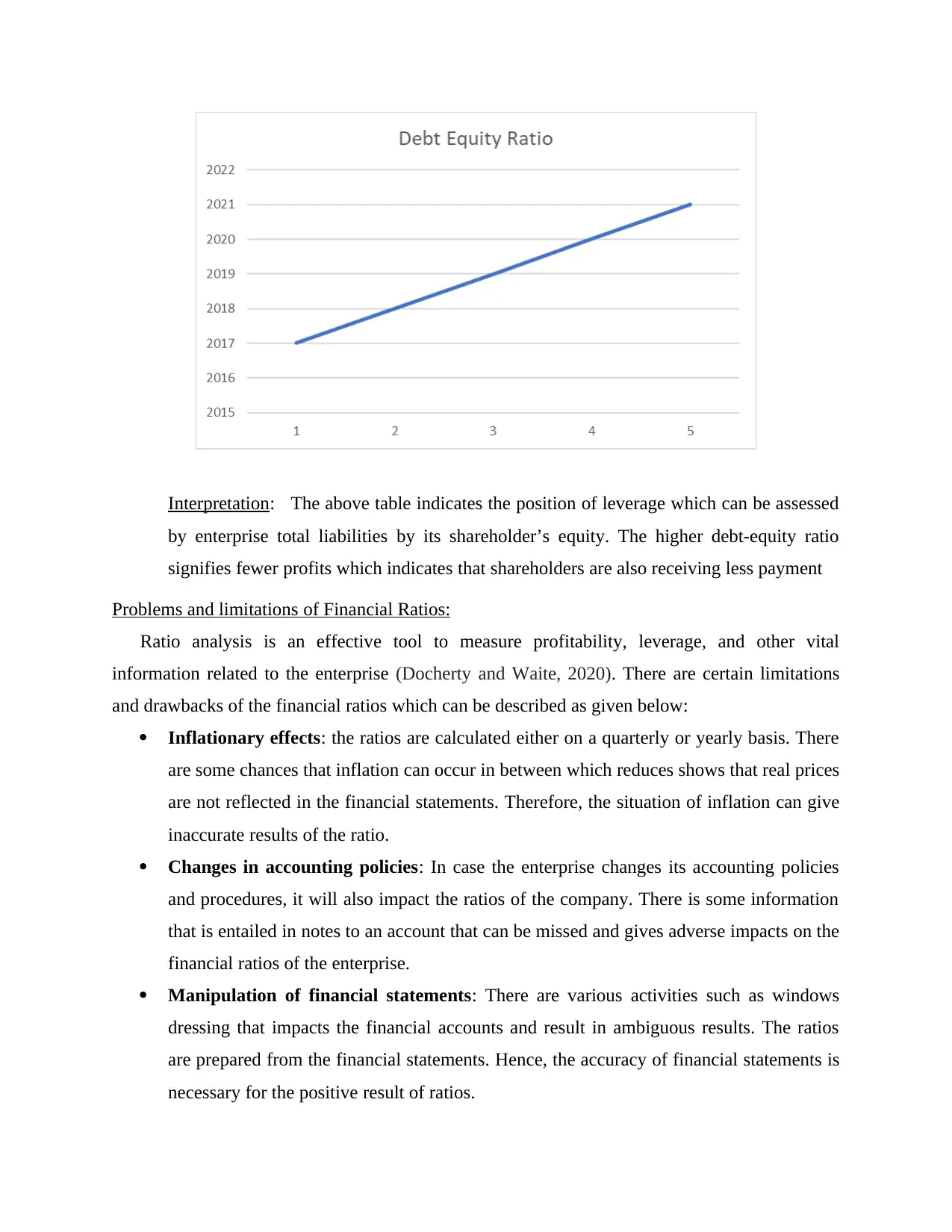
Interpretation: The above table indicates the position of leverage which can be assessed
by enterprise total liabilities by its shareholder’s equity. The higher debt-equity ratio
signifies fewer profits which indicates that shareholders are also receiving less payment
Problems and limitations of Financial Ratios:
Ratio analysis is an effective tool to measure profitability, leverage, and other vital
information related to the enterprise (Docherty and Waite, 2020). There are certain limitations
and drawbacks of the financial ratios which can be described as given below:
Inflationary effects: the ratios are calculated either on a quarterly or yearly basis. There
are some chances that inflation can occur in between which reduces shows that real prices
are not reflected in the financial statements. Therefore, the situation of inflation can give
inaccurate results of the ratio.
Changes in accounting policies: In case the enterprise changes its accounting policies
and procedures, it will also impact the ratios of the company. There is some information
that is entailed in notes to an account that can be missed and gives adverse impacts on the
financial ratios of the enterprise.
Manipulation of financial statements: There are various activities such as windows
dressing that impacts the financial accounts and result in ambiguous results. The ratios
are prepared from the financial statements. Hence, the accuracy of financial statements is
necessary for the positive result of ratios.
by enterprise total liabilities by its shareholder’s equity. The higher debt-equity ratio
signifies fewer profits which indicates that shareholders are also receiving less payment
Problems and limitations of Financial Ratios:
Ratio analysis is an effective tool to measure profitability, leverage, and other vital
information related to the enterprise (Docherty and Waite, 2020). There are certain limitations
and drawbacks of the financial ratios which can be described as given below:
Inflationary effects: the ratios are calculated either on a quarterly or yearly basis. There
are some chances that inflation can occur in between which reduces shows that real prices
are not reflected in the financial statements. Therefore, the situation of inflation can give
inaccurate results of the ratio.
Changes in accounting policies: In case the enterprise changes its accounting policies
and procedures, it will also impact the ratios of the company. There is some information
that is entailed in notes to an account that can be missed and gives adverse impacts on the
financial ratios of the enterprise.
Manipulation of financial statements: There are various activities such as windows
dressing that impacts the financial accounts and result in ambiguous results. The ratios
are prepared from the financial statements. Hence, the accuracy of financial statements is
necessary for the positive result of ratios.
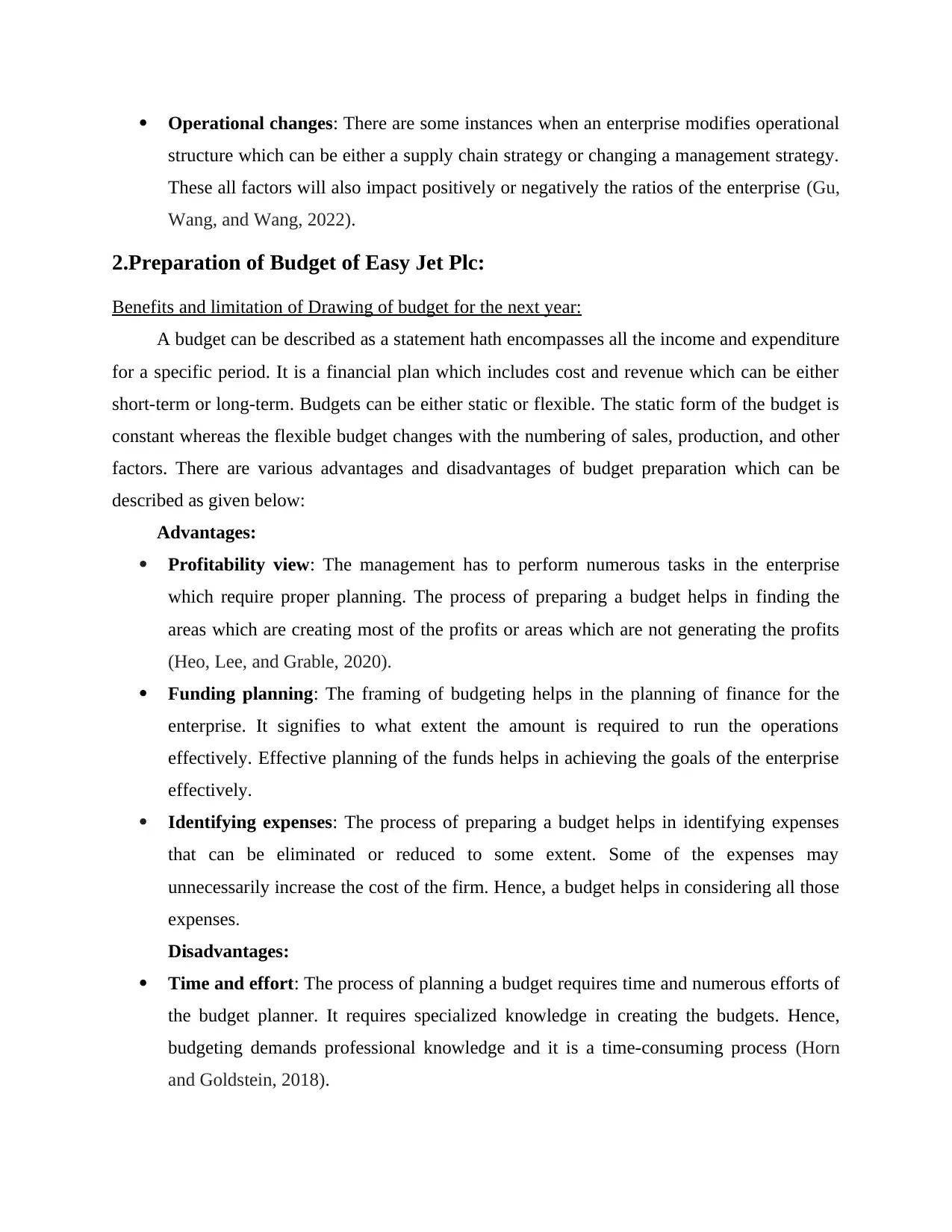
Operational changes: There are some instances when an enterprise modifies operational
structure which can be either a supply chain strategy or changing a management strategy.
These all factors will also impact positively or negatively the ratios of the enterprise (Gu,
Wang, and Wang, 2022).
2.Preparation of Budget of Easy Jet Plc:
Benefits and limitation of Drawing of budget for the next year:
A budget can be described as a statement hath encompasses all the income and expenditure
for a specific period. It is a financial plan which includes cost and revenue which can be either
short-term or long-term. Budgets can be either static or flexible. The static form of the budget is
constant whereas the flexible budget changes with the numbering of sales, production, and other
factors. There are various advantages and disadvantages of budget preparation which can be
described as given below:
Advantages:
Profitability view: The management has to perform numerous tasks in the enterprise
which require proper planning. The process of preparing a budget helps in finding the
areas which are creating most of the profits or areas which are not generating the profits
(Heo, Lee, and Grable, 2020).
Funding planning: The framing of budgeting helps in the planning of finance for the
enterprise. It signifies to what extent the amount is required to run the operations
effectively. Effective planning of the funds helps in achieving the goals of the enterprise
effectively.
Identifying expenses: The process of preparing a budget helps in identifying expenses
that can be eliminated or reduced to some extent. Some of the expenses may
unnecessarily increase the cost of the firm. Hence, a budget helps in considering all those
expenses.
Disadvantages:
Time and effort: The process of planning a budget requires time and numerous efforts of
the budget planner. It requires specialized knowledge in creating the budgets. Hence,
budgeting demands professional knowledge and it is a time-consuming process (Horn
and Goldstein, 2018).
structure which can be either a supply chain strategy or changing a management strategy.
These all factors will also impact positively or negatively the ratios of the enterprise (Gu,
Wang, and Wang, 2022).
2.Preparation of Budget of Easy Jet Plc:
Benefits and limitation of Drawing of budget for the next year:
A budget can be described as a statement hath encompasses all the income and expenditure
for a specific period. It is a financial plan which includes cost and revenue which can be either
short-term or long-term. Budgets can be either static or flexible. The static form of the budget is
constant whereas the flexible budget changes with the numbering of sales, production, and other
factors. There are various advantages and disadvantages of budget preparation which can be
described as given below:
Advantages:
Profitability view: The management has to perform numerous tasks in the enterprise
which require proper planning. The process of preparing a budget helps in finding the
areas which are creating most of the profits or areas which are not generating the profits
(Heo, Lee, and Grable, 2020).
Funding planning: The framing of budgeting helps in the planning of finance for the
enterprise. It signifies to what extent the amount is required to run the operations
effectively. Effective planning of the funds helps in achieving the goals of the enterprise
effectively.
Identifying expenses: The process of preparing a budget helps in identifying expenses
that can be eliminated or reduced to some extent. Some of the expenses may
unnecessarily increase the cost of the firm. Hence, a budget helps in considering all those
expenses.
Disadvantages:
Time and effort: The process of planning a budget requires time and numerous efforts of
the budget planner. It requires specialized knowledge in creating the budgets. Hence,
budgeting demands professional knowledge and it is a time-consuming process (Horn
and Goldstein, 2018).
⊘ This is a preview!⊘
Do you want full access?
Subscribe today to unlock all pages.

Trusted by 1+ million students worldwide
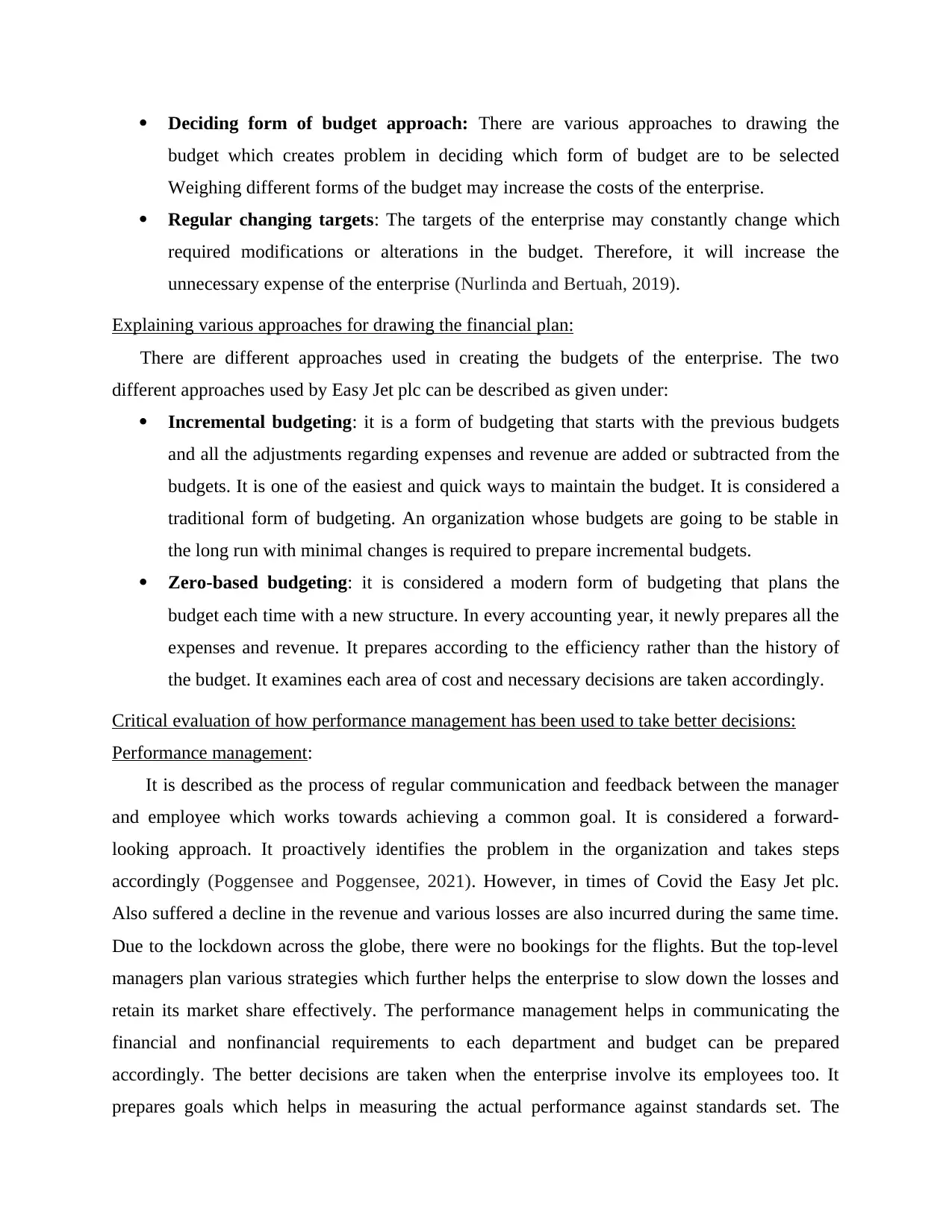
Deciding form of budget approach: There are various approaches to drawing the
budget which creates problem in deciding which form of budget are to be selected
Weighing different forms of the budget may increase the costs of the enterprise.
Regular changing targets: The targets of the enterprise may constantly change which
required modifications or alterations in the budget. Therefore, it will increase the
unnecessary expense of the enterprise (Nurlinda and Bertuah, 2019).
Explaining various approaches for drawing the financial plan:
There are different approaches used in creating the budgets of the enterprise. The two
different approaches used by Easy Jet plc can be described as given under:
Incremental budgeting: it is a form of budgeting that starts with the previous budgets
and all the adjustments regarding expenses and revenue are added or subtracted from the
budgets. It is one of the easiest and quick ways to maintain the budget. It is considered a
traditional form of budgeting. An organization whose budgets are going to be stable in
the long run with minimal changes is required to prepare incremental budgets.
Zero-based budgeting: it is considered a modern form of budgeting that plans the
budget each time with a new structure. In every accounting year, it newly prepares all the
expenses and revenue. It prepares according to the efficiency rather than the history of
the budget. It examines each area of cost and necessary decisions are taken accordingly.
Critical evaluation of how performance management has been used to take better decisions:
Performance management:
It is described as the process of regular communication and feedback between the manager
and employee which works towards achieving a common goal. It is considered a forward-
looking approach. It proactively identifies the problem in the organization and takes steps
accordingly (Poggensee and Poggensee, 2021). However, in times of Covid the Easy Jet plc.
Also suffered a decline in the revenue and various losses are also incurred during the same time.
Due to the lockdown across the globe, there were no bookings for the flights. But the top-level
managers plan various strategies which further helps the enterprise to slow down the losses and
retain its market share effectively. The performance management helps in communicating the
financial and nonfinancial requirements to each department and budget can be prepared
accordingly. The better decisions are taken when the enterprise involve its employees too. It
prepares goals which helps in measuring the actual performance against standards set. The
budget which creates problem in deciding which form of budget are to be selected
Weighing different forms of the budget may increase the costs of the enterprise.
Regular changing targets: The targets of the enterprise may constantly change which
required modifications or alterations in the budget. Therefore, it will increase the
unnecessary expense of the enterprise (Nurlinda and Bertuah, 2019).
Explaining various approaches for drawing the financial plan:
There are different approaches used in creating the budgets of the enterprise. The two
different approaches used by Easy Jet plc can be described as given under:
Incremental budgeting: it is a form of budgeting that starts with the previous budgets
and all the adjustments regarding expenses and revenue are added or subtracted from the
budgets. It is one of the easiest and quick ways to maintain the budget. It is considered a
traditional form of budgeting. An organization whose budgets are going to be stable in
the long run with minimal changes is required to prepare incremental budgets.
Zero-based budgeting: it is considered a modern form of budgeting that plans the
budget each time with a new structure. In every accounting year, it newly prepares all the
expenses and revenue. It prepares according to the efficiency rather than the history of
the budget. It examines each area of cost and necessary decisions are taken accordingly.
Critical evaluation of how performance management has been used to take better decisions:
Performance management:
It is described as the process of regular communication and feedback between the manager
and employee which works towards achieving a common goal. It is considered a forward-
looking approach. It proactively identifies the problem in the organization and takes steps
accordingly (Poggensee and Poggensee, 2021). However, in times of Covid the Easy Jet plc.
Also suffered a decline in the revenue and various losses are also incurred during the same time.
Due to the lockdown across the globe, there were no bookings for the flights. But the top-level
managers plan various strategies which further helps the enterprise to slow down the losses and
retain its market share effectively. The performance management helps in communicating the
financial and nonfinancial requirements to each department and budget can be prepared
accordingly. The better decisions are taken when the enterprise involve its employees too. It
prepares goals which helps in measuring the actual performance against standards set. The
Paraphrase This Document
Need a fresh take? Get an instant paraphrase of this document with our AI Paraphraser
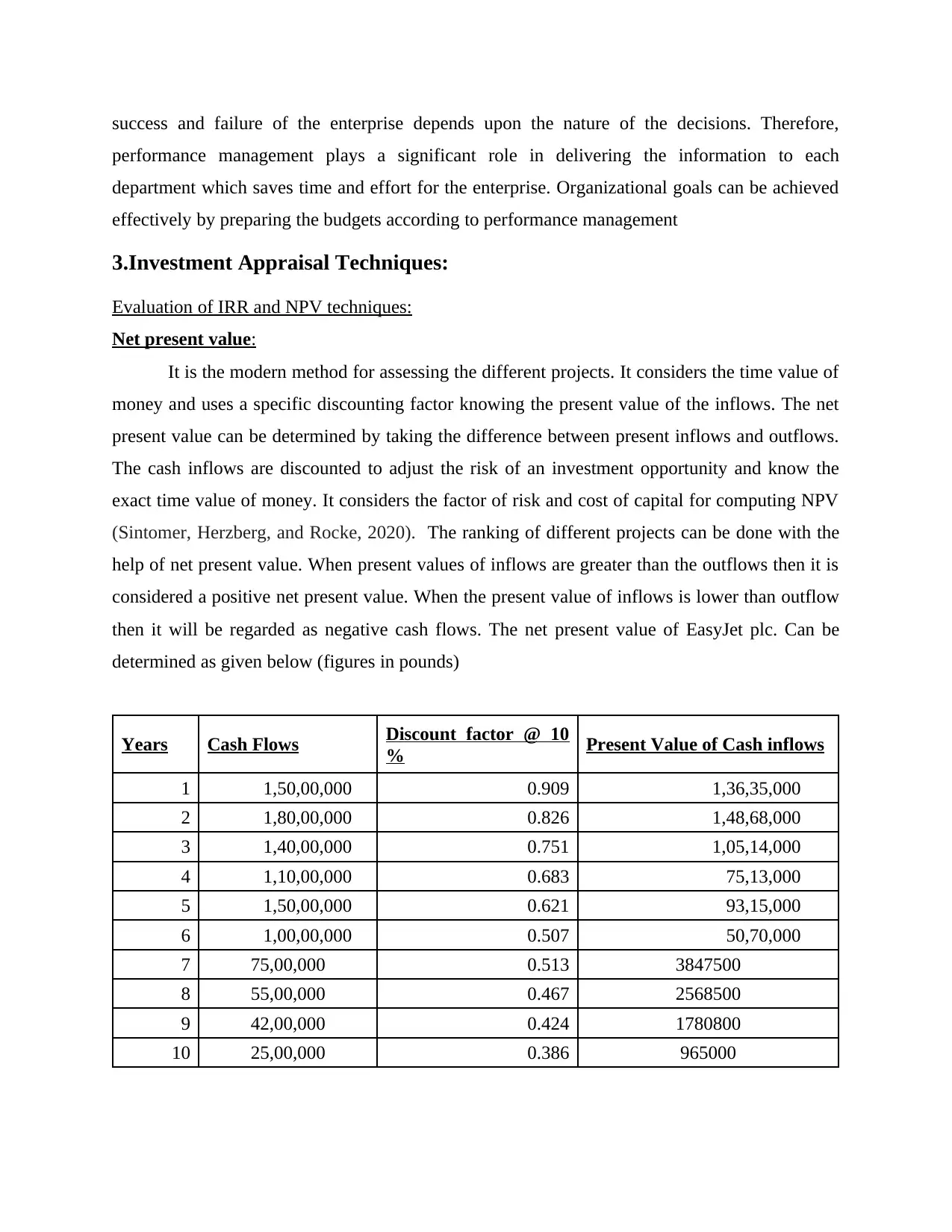
success and failure of the enterprise depends upon the nature of the decisions. Therefore,
performance management plays a significant role in delivering the information to each
department which saves time and effort for the enterprise. Organizational goals can be achieved
effectively by preparing the budgets according to performance management
3.Investment Appraisal Techniques:
Evaluation of IRR and NPV techniques:
Net present value:
It is the modern method for assessing the different projects. It considers the time value of
money and uses a specific discounting factor knowing the present value of the inflows. The net
present value can be determined by taking the difference between present inflows and outflows.
The cash inflows are discounted to adjust the risk of an investment opportunity and know the
exact time value of money. It considers the factor of risk and cost of capital for computing NPV
(Sintomer, Herzberg, and Rocke, 2020). The ranking of different projects can be done with the
help of net present value. When present values of inflows are greater than the outflows then it is
considered a positive net present value. When the present value of inflows is lower than outflow
then it will be regarded as negative cash flows. The net present value of EasyJet plc. Can be
determined as given below (figures in pounds)
Years Cash Flows Discount factor @ 10
% Present Value of Cash inflows
1 1,50,00,000 0.909 1,36,35,000
2 1,80,00,000 0.826 1,48,68,000
3 1,40,00,000 0.751 1,05,14,000
4 1,10,00,000 0.683 75,13,000
5 1,50,00,000 0.621 93,15,000
6 1,00,00,000 0.507 50,70,000
7 75,00,000 0.513 3847500
8 55,00,000 0.467 2568500
9 42,00,000 0.424 1780800
10 25,00,000 0.386 965000
performance management plays a significant role in delivering the information to each
department which saves time and effort for the enterprise. Organizational goals can be achieved
effectively by preparing the budgets according to performance management
3.Investment Appraisal Techniques:
Evaluation of IRR and NPV techniques:
Net present value:
It is the modern method for assessing the different projects. It considers the time value of
money and uses a specific discounting factor knowing the present value of the inflows. The net
present value can be determined by taking the difference between present inflows and outflows.
The cash inflows are discounted to adjust the risk of an investment opportunity and know the
exact time value of money. It considers the factor of risk and cost of capital for computing NPV
(Sintomer, Herzberg, and Rocke, 2020). The ranking of different projects can be done with the
help of net present value. When present values of inflows are greater than the outflows then it is
considered a positive net present value. When the present value of inflows is lower than outflow
then it will be regarded as negative cash flows. The net present value of EasyJet plc. Can be
determined as given below (figures in pounds)
Years Cash Flows Discount factor @ 10
% Present Value of Cash inflows
1 1,50,00,000 0.909 1,36,35,000
2 1,80,00,000 0.826 1,48,68,000
3 1,40,00,000 0.751 1,05,14,000
4 1,10,00,000 0.683 75,13,000
5 1,50,00,000 0.621 93,15,000
6 1,00,00,000 0.507 50,70,000
7 75,00,000 0.513 3847500
8 55,00,000 0.467 2568500
9 42,00,000 0.424 1780800
10 25,00,000 0.386 965000
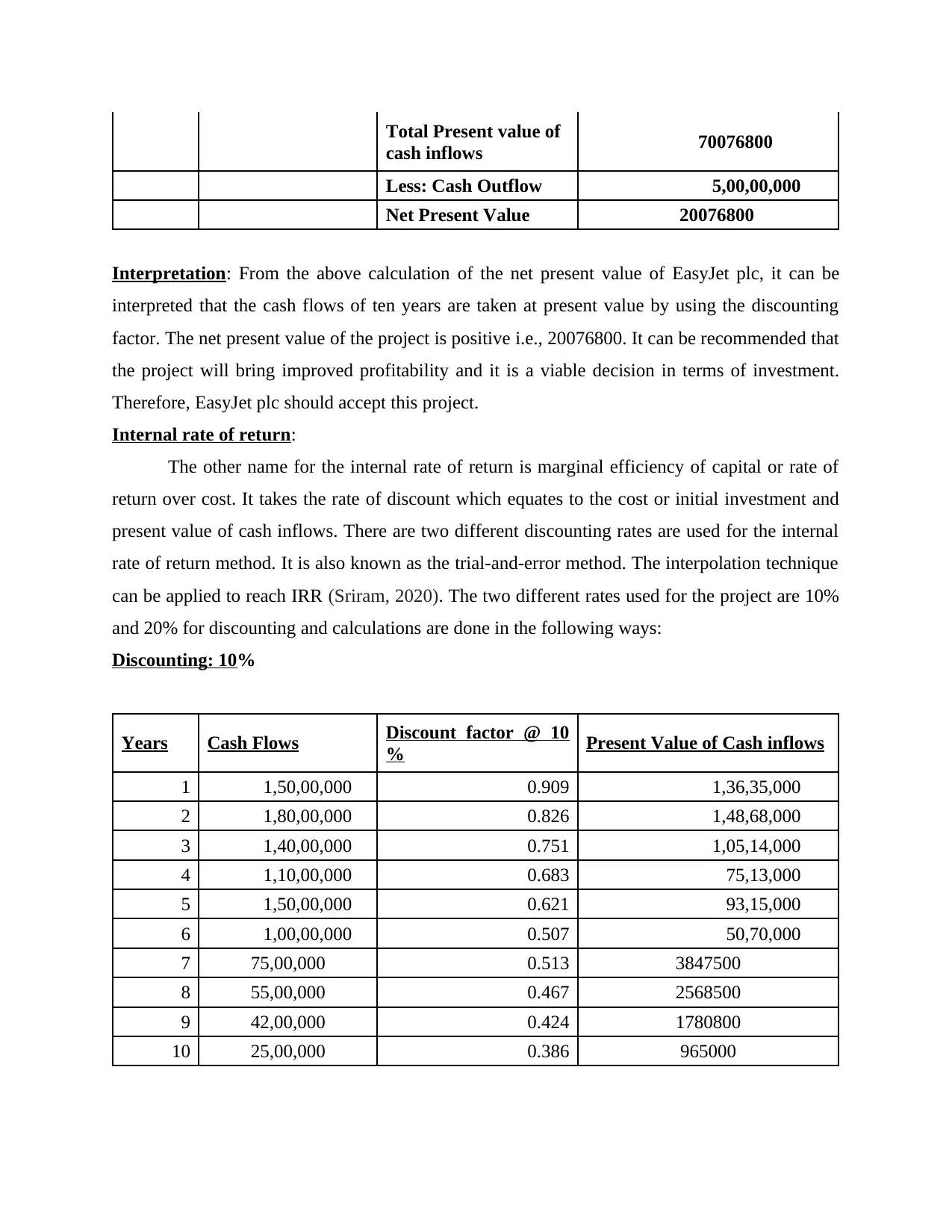
Total Present value of
cash inflows 70076800
Less: Cash Outflow 5,00,00,000
Net Present Value 20076800
Interpretation: From the above calculation of the net present value of EasyJet plc, it can be
interpreted that the cash flows of ten years are taken at present value by using the discounting
factor. The net present value of the project is positive i.e., 20076800. It can be recommended that
the project will bring improved profitability and it is a viable decision in terms of investment.
Therefore, EasyJet plc should accept this project.
Internal rate of return:
The other name for the internal rate of return is marginal efficiency of capital or rate of
return over cost. It takes the rate of discount which equates to the cost or initial investment and
present value of cash inflows. There are two different discounting rates are used for the internal
rate of return method. It is also known as the trial-and-error method. The interpolation technique
can be applied to reach IRR (Sriram, 2020). The two different rates used for the project are 10%
and 20% for discounting and calculations are done in the following ways:
Discounting: 10%
Years Cash Flows Discount factor @ 10
% Present Value of Cash inflows
1 1,50,00,000 0.909 1,36,35,000
2 1,80,00,000 0.826 1,48,68,000
3 1,40,00,000 0.751 1,05,14,000
4 1,10,00,000 0.683 75,13,000
5 1,50,00,000 0.621 93,15,000
6 1,00,00,000 0.507 50,70,000
7 75,00,000 0.513 3847500
8 55,00,000 0.467 2568500
9 42,00,000 0.424 1780800
10 25,00,000 0.386 965000
cash inflows 70076800
Less: Cash Outflow 5,00,00,000
Net Present Value 20076800
Interpretation: From the above calculation of the net present value of EasyJet plc, it can be
interpreted that the cash flows of ten years are taken at present value by using the discounting
factor. The net present value of the project is positive i.e., 20076800. It can be recommended that
the project will bring improved profitability and it is a viable decision in terms of investment.
Therefore, EasyJet plc should accept this project.
Internal rate of return:
The other name for the internal rate of return is marginal efficiency of capital or rate of
return over cost. It takes the rate of discount which equates to the cost or initial investment and
present value of cash inflows. There are two different discounting rates are used for the internal
rate of return method. It is also known as the trial-and-error method. The interpolation technique
can be applied to reach IRR (Sriram, 2020). The two different rates used for the project are 10%
and 20% for discounting and calculations are done in the following ways:
Discounting: 10%
Years Cash Flows Discount factor @ 10
% Present Value of Cash inflows
1 1,50,00,000 0.909 1,36,35,000
2 1,80,00,000 0.826 1,48,68,000
3 1,40,00,000 0.751 1,05,14,000
4 1,10,00,000 0.683 75,13,000
5 1,50,00,000 0.621 93,15,000
6 1,00,00,000 0.507 50,70,000
7 75,00,000 0.513 3847500
8 55,00,000 0.467 2568500
9 42,00,000 0.424 1780800
10 25,00,000 0.386 965000
⊘ This is a preview!⊘
Do you want full access?
Subscribe today to unlock all pages.

Trusted by 1+ million students worldwide
1 out of 17
Related Documents
Your All-in-One AI-Powered Toolkit for Academic Success.
+13062052269
info@desklib.com
Available 24*7 on WhatsApp / Email
![[object Object]](/_next/static/media/star-bottom.7253800d.svg)
Unlock your academic potential
Copyright © 2020–2026 A2Z Services. All Rights Reserved. Developed and managed by ZUCOL.





